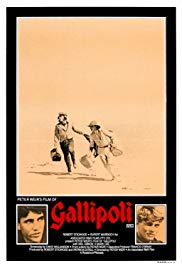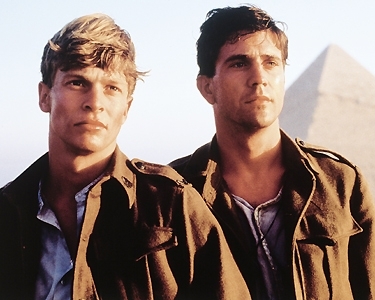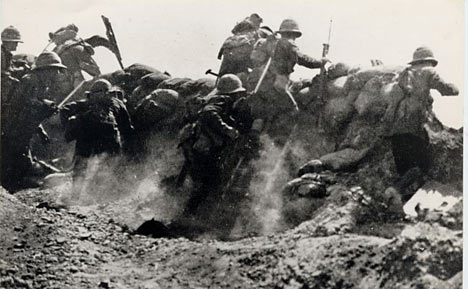GALLIPOLI
SUBJECTS — World/WWI, Australia & Turkey;
SOCIAL-EMOTIONAL LEARNING — Courage in War; Friendship;
MORAL-ETHICAL EMPHASIS — Trustworthiness.
AGE: 13+; MPAA Rating — PG;
Drama; 1981; 111 minutes; Color. Available from Amazon.com.
There is NO AI content on this website. All content on TeachWithMovies.org has been written by human beings.

SUBJECTS — World/WWI, Australia & Turkey;
SOCIAL-EMOTIONAL LEARNING — Courage in War; Friendship;
MORAL-ETHICAL EMPHASIS — Trustworthiness.
AGE: 13+; MPAA Rating — PG;
Drama; 1981; 111 minutes; Color. Available from Amazon.com.
TWM offers the following worksheets to keep students’ minds on the movie and direct them to the lessons that can be learned from the film.
Film Study Worksheet for a Work of Historical Fiction and
Worksheet for Cinematic and Theatrical Elements and Their Effects.
Teachers can modify the movie worksheets to fit the needs of each class. See also TWM’s Historical Fiction in Film Cross-Curricular Homework Project.
This film shows the ill-fated attack on the Turk lines at Gallipoli by soldiers of ANZAC (Australian and New Zealand Army Corps) during the First World War.

Selected Awards:
1981 Australian Film Institute: Best Film, Best Actor (Gibson); 1982 Golden Globe Awards Nominations: Best Foreign Film.
Featured Actors:
Mel Gibson, Mark Lee, Bill Kerr, David Argue, Tim McKenzie, Robert Grubb.
Director:
Peter Weir.
In war, the lives of soldiers are often lost due to mistaken tactics, stupidity, and bad luck. This film shows a cardinal example of this phenomenon. Other themes are the pressure of the rush to enlist, friendship among soldiers, and their courage in the face of sure and imminent death. This film will introduce children to the roles that Australia and Turkey played in the First World War, trench warfare, and the failed Gallipoli campaign.
MODERATE: The young soldiers (and the viewer) look at pictures of nude Egyptian prostitutes for a short period. The young soldiers are seen going into a brothel. There are several historical inaccuracies, e.g., the officer who insisted upon the charge being undertaken was Australian and not British; contrary to the implications of the film, the British did their share of fighting at Gallipoli, and suffered heavy casualties.
Simply comment that this movie shows that in war, a person’s life is subject to many chance events. This is the major part of the heroism of being a soldier. If there is a little bit of bad luck you can be placed in situations in which there is no chance of escape. Then ask and help your child to answer the Quick Discussion Question.

See Learning Guide to All Quiet on the Western Front for a short description of trench warfare and casualties in WWI. See Learning Guide to Paths of Glory for a brief description of the causes of the First World War.
Turkey was a German ally during the First World War. Winston Churchill, at that time First Lord of the British Admiralty, thought that if the British could send the Navy through the Dardanelles they could point their guns at Istanbul and force Turkey out of the War. But Turkish shore batteries on the Gallipoli Peninsula and mine fields in the Dardanelles frustrated the British plan. Churchill then decided to land troops at Gallipoli to take out the shore batteries.
The invasion was unsuccessful. The defenders were commanded by Kemal Ataturk, a determined officer who later led the Turkish revolution against the Ottomans. Ataturk was the father and first President of the modern state of Turkey. Eventually, after almost 300,000 casualties and no results except for the death of about 300,000 Turks, the British and ANZAC troops withdrew. Churchill was relieved of his position as First Lord of the Admiralty and ever after was taunted by the opposition with the cry: “What about the Dardanelles?”
On the whole, this film is historically accurate. The purpose of the attack was to divert Turkish attention from the real thrust of the Allied forces. The artillery barrage, designed to force the Turks out of their trenches, was scheduled to continue until 4:30 p.m. For some reason, the artillery barrage stopped at 4:23 p.m. The ANZAC attack occurred on time at 4:30 p.m. In those seven minutes, the Turks went back to their positions in the trenches and were able to repulse the ANZAC attack.
Life in the trenches was probably worse than is shown in the film. The Australians, knowing they would die in the attack, left their watches, rings, and notes for their loved ones in the trenches.
Australia sent 300,000 men to fight in World War I and suffered 60,000 deaths, a casualty rate of 20%.
1. See Discussion Questions for Use With any Film that is a Work of Fiction.
2. Should the Australian officer have ordered his men over the top on the final charge?
3. How does the charge shown in this movie differ from the failed attack on the virtually impregnable Fort Wagner shown in the film Glory?
Suggested Response:
The soldiers of the Massachusetts 54th used the attack on Fort Wagner to prove that black soldiers could fight well in the mid-19th-century war against hopeless odds; while the attack on Fort Wagner failed to dislodge the Confederate troops, it as a triumph for the Massachusetts 54th and black people in the U.S.
4. On a map or a globe, show your child Istanbul, the Gallipoli peninsula and the Dardanelles on a map.
1. Is it right to sacrifice your life for a lost cause?
Discussion Questions Relating to Ethical Issues will facilitate the use of this film to teach ethical principles and critical viewing. Additional questions are set out below.
(Be honest; Don’t deceive, cheat or steal; Be reliable — do what you say you’ll do; Have the courage to do the right thing; Build a good reputation; Be loyal — stand by your family, friends, and country)
1. What does this film tell you about the importance of soldiers doing what they say they will do?
This Learning Guide was last updated on December 10, 2009.